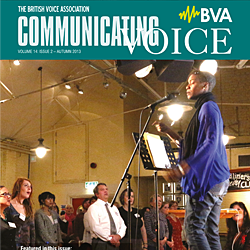About the Association
Archived newsletter articles
The Singer's Speaking Voice
By Anne-Marie Speed, with responses from Peter T Harrison and Natasha Dobie
Singers spend a significant part of their income investing in, maintaining and looking after their voices through singing lessons and coaching. The necessity for these is obvious for the professional singer.
However, the speaking voice is rarely given much attention, either because the need for such care is not perceived or through a belief that the singing training will take care of all vocal needs. Yet according to our colleagues in the voice clinics observing singers who are referred, it is often not the singer's singing voice that has brought them there, but their speaking voice.
To understand why separate attention for the speaking voice should be considered as an integral part of a singer's training, and not simply as an option, it is useful to understand the significant differences in production between speaking and classical singing.
First of all, let us consider the differences in dimension and posture of the larynx and vocal tract between singing and speaking.
Classical singing training encourages, among other conditions, a lowering of the larynx, with a simultaneous 'tilting' forward of the thyroid cartilage. As Jo Estill's research has observed, this is the posture of crying or sobbing. The muscles of the larynx and vocal tract are working to pull the larynx down and the thyroid forward.
In normal speech however, the larynx remains in a neutral position and the cartilages of the larynx remain vertical. There is no thyroid tilt in normal speech. We do hear it however, when someone is speaking who is overcome with emotion, and is trying not to cry. The voice immediately takes on a different quality, which is usually perceived by the listener.
Many singers work so long and so hard at assuming the singing posture that is essential for the production of an acceptable classical sound, that it becomes an habitual posture, even in speech. They continue to 'sing' when they speak. By not allowing themselves to revert to a normal speech position, they are at risk of two possible consequences.
Firstly, by not releasing the low laryngeal position and allowing the thyroid to return to its vertical posture, the singer never lets the voice rest. Speech as a quality does not require such hard work and by maintaining a singing position all the time, the singer never gives the voice 'time off'. This can lead to problems of fatigue as well as inflexibility of the crico-thyroid mechanism that in turn can lead, paradoxically it may seem, to problems in pitching and the efficient production of sung tone.
Secondly, the effect of all this unnecessary work is that the sound that is produced doesn't sound like speech. It sounds over-produced and lacks the freedom to make the rapid and spontaneous changes of pitch that is such an identifying feature of speech.
This is clearly heard in spoken dialogue in opera for example, where many singers continue to 'sing' as they speak with the effect that it in fact sounds nothing like speech but a continuation of singing, without an obvious melody. It should be pointed out however, that to make the shift from one to the other is not easy, and it is entirely understandable why this happens, although it should not be considered unalterable.
Certain simple exercises at the end of practice, rehearsal or performance that release the larynx, allowing it to return to an efficient speech position should be considered as much a part of a singer's routine as any other exercise. The voice will recover more quickly and work more efficiently in the daily demands of ordinary conversation. After all, we spend more time speaking than we do singing, even singers, and a little bit of attention to the speaking voice in its own right will pay off in less laryngeal fatigue. We have one larynx for both speaking and singing but understanding some key differences between them can significantly help them both.
Peter T Harrison
in response to 'The Singer's Speaking Voice'
The importance of Anne-Marie Speed's article, The Singer's Speaking Voice (Communicating Voice Volume 2.3, April 2001) cannot be overestimated: It raises issues more profound and complex than might at first be imagined.
Fundamental to the issue is the universal or original voice - that with which we were born, regardless of race or culture.
The classical singing voice is so called because it is the voice employed for Western classical music, as distinct from 'pop' or other cultural variants. There was a time when this was the only recognised singing voice: now it is categorised by use.
Whereas the rediscovery of our innate ability to sing was a cause for bel canto success, subsequent lack of belief or understanding in the unique scope and potential of this voice has lead to a poorly imitated, if acceptable, sound or a 'voice type' formulated for a specific purpose. Its performance suffers from extraneous efforts to effect the very skills which it should possess by nature, not artifice.
It may, however, be more helpful and revealing to consider voice apart from particular usage.
The natural, universal voice is balanced and free by definition and, importantly in the present context, is therefore the only truly healthy one. Training or care that does not acknowledge this 'original' voice must lead to a one-sided and inhibited vocal dynamic.
With the current fad for stylistic cross-over, categorisation by use has led to moves to justify, or prove as healthy, voices which are aberrant vocal forms; as if to say: 'Belting and pop are here to stay, so why not make them respectable?'
To understand speech 'problems' - which, of course, are not exclusive to some singers or to cases considered pathological in origin - we need to go a long way back and understand that, for all its normalcy and, indeed, supremacy in everyday life, the speech voice is also a degenerate form of vocalisation. The fact that sobbing and crying have for centuries been understood as intimately connected with singing only suggests that the singing voice has older, more spontaneous roots than that of speaking. We might note in passing that a baby does not easily tire (physically) of crying, let alone need a voice clinic!
However, when we examine both the path upon which the tiny human's voice appears to be set and the influences that subsequently upset or divert it, we get a picture of a partially realised, functionally restricted or collapsed vocal apparatus. From this alone, both the singing voice (exemplified, thankfully, from time to time by aptly called 'natural singers') and reasons for its demise may be understood. It follows that speaking on this neglected, inefficient instrument is necessarily a strain. Any one-sidedness, deliberate or otherwise, leads to problems: For most normal speakers this is the main reason why they cannot sing (casualties of civilisation, perhaps?); for the average singer the result is the use of two very different voices - one 'fixed up' for the purposes of 'singing' - and the other more or less collapsed, for speaking.
The activity of the crico-thyroid muscles in good singing is rendered free and flexible by their paired counterpart, sternothyroid muscles; frontal 'depressors' of the larynx and part (only) of the elastic muscular mechanism that ensures that the larynx sings without impediment or strain.
In this naturally erected state the larynx is also free to speak. The natural, as distinct from normal, singer usually speaks and sings with the voice with which s/he was born. In this free state alone can the singer be said to sing with a heightened form of speaking; his/her speaking voice is healthy because it derives from singing. The singer who sings with the natural universal voice has no problem whatever with speaking: his/her larynx is suspended in such a way that it is free to function with skill and alacrity - not fixed or figured in a special position according to use or style. S/he is not trying to cry. In truly healthy speaking, this singing freedom prevails because there is simply no fundamental difference.
Peter Harrison is Professor Residente Estudio de Opera do Porto
Natasha Dobie
in response to to Peter Harrison's contribution
Peter Harrison's article (published in volume 3, Issue 2 October 2002) poses some very interesting questions with regard to the 'natural', 'classical', 'commercial' and 'speaking' voice. It is true that we all have our own combination of frequencies and sound waves that we are born with, and it is true that the baby's voice does not easily tire (it is in effect free), but I am sure that which ever style or 'voice type' we singers choose to sing in, the one voice that is universally unacceptable is the one that sounds like a screaming baby!
To say that "There was a time when the classical singing voice was the only recognised singing voice", is stating that any natural or spontaneous release of emotion and expression is a "degenerate" form of vocalisation. The origin of the classical singing voice began with the evolution of the church, with the 'repression' of a natural, spontaneous and free voice. For centuries, strict rules disallowed vocal uninhibited freedom. The female voice was considered too sexual. How more repressive and unnatural can you get that castration of boys to strive towards a vocal excellence? And yet, this is the very era generally believed to be the one of the 'bel canto' golden ages, a natural voice?
So, when we modern singers in our current 'fad' for stylistic cross-over talk about the 'classical singing voice' as distinct from pop or other cultural variants, we are in effect talking about the unnatural voice as opposed to the natural one that originated from secular music, that is; a spontaneous release of emotion and expression, and is indeed the origin of pop, soul, belt etc., etc...
Regarding his comments about the speaking voice deriving from the singing voice, it is said that "man first lifted his voice in imitation of the mating calls of birds in his need to attract a mate, and mimicry of animal noises so as to drive away evil spirits." (Darwin). With myths like these, one has to imagine whether the roots of the voice lie in that of speaking or singing. I would imagine the two came simultaneously... birds sing and animals grunt, croak, call etc., but most certainly calling and yelling (belt) were profound and natural ways man first began to communicate, out hunting and in the tribal communities. A vocalised cry and sob did not come about until the voice was already in profound use. It is also interesting to note that according to psychoanalysts and psychologists, when an adult is dealing with the most basic, infantile and repressed pain from their infancy, the tears that are released are more often than not, shed in silence. Therefore to say that the singing voice has older and more spontaneous roots than that of speaking is highly subjective to personal belief, the truth of which we will never know. So, to state that "vocal qualities such as belt and pop are aberrant vocal forms" is to say that what is most basic, natural and primary in vocal production is unhealthy.
I do agree, that for the average (classical) singer, we can end up with two different voices, "fixed up" or "collapsed" depending on it's function, and I do believe that when the larynx is free we should be able to speak and sing spontaneously with a modified and cultured voice that derives from the basic qualities we are born with, and that fundamentally there is no difference between healthy singing and speaking. But, in order to achieve vocal supremacy ALL the basic fundamental possibilities of vocal production must be taken into consideration and built on. Then we have a healthy voice that will naturally be able to cross over if the musical influences of stylistic differences are sufficient within the singer.
There are no 'right or wrong, degenerate or aberrant' forms of vocalisation in a healthy voice. Healthy does not mean beautiful. Listen to the baby! The problems occur when we try to make the voice beautiful, or exciting, or big, not when we are using a different physiological set up for a different stylistic demand.
The human voice is the most remarkable gift that nature has blessed us with. It has infinite capabilities. In a good raw (natural) instrument, culture, genre and influences should enhance and not inhibit the singer. With study, knowledge, technique and sufficient building, a good voice inside a musically talented person should enable endless possibilities and few restrictions with regards to style, type and vocal dynamics.
Natasha Dobie is a freelance singer, having studied with both Voice Craft and Peter Harrison.
More archived content online
Disclaimer
Neither the British Voice Association nor the Editor can be held responsible for errors or any consequences arising from the use of information contained in its newsletters (or extracts from its newsletters published online); the views and opinions expressed do not necessarily reflect those of the British Voice Association (BVA) or the Editor, neither does the publication of advertisements constitute any endorsement by the BVA or Editor of any products or services featured.

 Join us Now!
Join us Now! our newsletter
our newsletter free voice care leaflets & information – download here
free voice care leaflets & information – download here Help our work by donating while you shop
Help our work by donating while you shop